 Pharaoh Hound is originated from Malta but Beabull is originated from United States. Pharaoh Hound may grow 23 cm / 10 inches higher than Beabull. Pharaoh Hound may weigh 14 kg / 31 pounds more than Beabull. Pharaoh Hound may live 3 years more than Beabull. Both Pharaoh Hound and Beabull has almost same litter size. Pharaoh Hound requires Low Maintenance. But Beabull requires Moderate Maintenance
Pharaoh Hound is originated from Malta but Beabull is originated from United States. Pharaoh Hound may grow 23 cm / 10 inches higher than Beabull. Pharaoh Hound may weigh 14 kg / 31 pounds more than Beabull. Pharaoh Hound may live 3 years more than Beabull. Both Pharaoh Hound and Beabull has almost same litter size. Pharaoh Hound requires Low Maintenance. But Beabull requires Moderate Maintenance
Basic Information
Group:
Hound dog
Companion dog
undefined
Malta
United States
Life Span:
11 - 14 Years
8 - 11 Years
Other Names:
Kelb tal Fennec
None
Colors Available:
Tan or red
white, brown brindle
Coat:
Short and smooth
have short, coarse hair that tends to shed a lot
Temperament:
Affectionate, Alert, Cheerful, Courageous, Curious, Energetic, Friendly, Gentle, Independent, Intelligent, Lively, Loving, Loyal, Outgoing, Playful, Protective, Quiet, Responsive, Social, Stubborn, Territorial
Independent, Loving, Loyal, Playful
Grooming:
Low Maintenance
Moderate Maintenance
Trainability:
Easy
Moderate
New Owners Friendly:
Yes
Yes
History
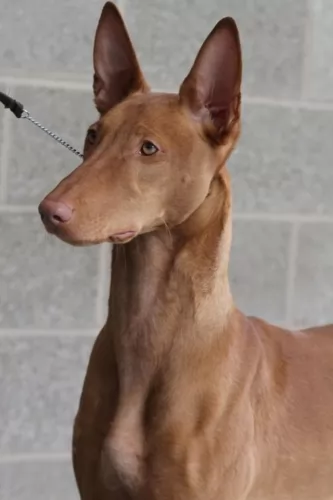 The Pharaoh Hound hails from Malta and is the national dog there. These dogs are rare and are looked upon as endangered. Because they are a primitive type dog, they enjoy good health.
The Pharaoh Hound hails from Malta and is the national dog there. These dogs are rare and are looked upon as endangered. Because they are a primitive type dog, they enjoy good health.
It has always been used as a hunting dog for rabbits. The dog has been recreated from mixing a combination of other breeds. It certainly seems to be an ancient dog breed, having existed for more than 2 000 years.
It is thought that the dog was imported to Malta by Phoenician traders. The dog has been classified as a member of the sighthound group, and arrived in England in the 1930s and to the USA in 1967. The breed was also officially recognized by the American Kennel Club in 1984.
The Beabull is known as a designer breed rather than a purebred. The Beabull is a cross between a Beagle and an English Bulldog. This breed is a loving dog, playful and physically strong. They are independent and can be stubborn. Their origins are not well documented, but it is thought they were developed about 20 years ago. Although not recognized by the American Kennel Club because they are not purebred dogs
Description
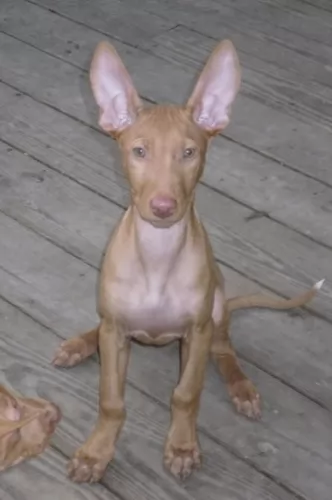 The Pharoah Hound is an elegant looking dog standing at roughly between 53 and 63cm and weighing 18 to 27kg.
The Pharoah Hound is an elegant looking dog standing at roughly between 53 and 63cm and weighing 18 to 27kg.
They are sleek dogs without any bulkiness about them and the coat is tight fitting with short smooth hair. The coat is a tan or red color, the eyes bright and the color of amber. The ears are fairly large and erect and the long tail slim with sometimes a white tip. The skin can be thin so the dog can be sensitive to the cold.
The neck of the dog is long and lean, as are the legs. An interesting aspect with this dog is that when the dog becomes excited its ears and nose become bright pink.
Temperament:
Pharoah Hounds are calm dogs and they can live in the city or in the countryside. They love kids and will be a wonderful playmate for them. Once he has had a lot of exercise and play, he is the kind of dog that will settle down happily with his human family for some quiet time.
Just as with any other dog, he will require training and socialization to make him obedient and better behaved.
The first generations of the Beabulls are a 50-50 mix, but most of the breed today are multigenerational dogs. This means a Beabull is mixed with another Beabull to try to create a purebred over time. Most of the Beabulls are a mixture and are very unpredictable in their looks and characteristics, depending upon which of the original parent breeds they favor most.
Many will retain the wrinkles, short legs, underbite and short tail of the Bulldog. Others will have the long droopy ears and long muzzles of the Beagle. Most will have coarse, short coats and shed quite a bit. They are medium to large depending upon which size Beagle is used in the crossing.
Characteristics
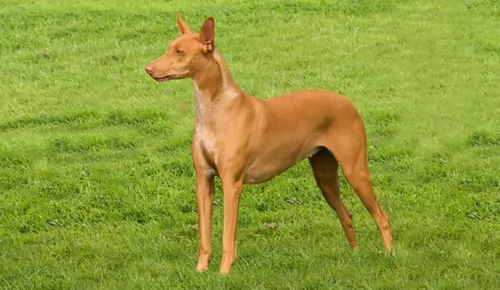 The Pharaoh Hound is quite interesting in a number of ways and he is independent, strong-willed and able to entertain and amuse himself.
The Pharaoh Hound is quite interesting in a number of ways and he is independent, strong-willed and able to entertain and amuse himself.
He loves to join in with the children and be part of their games. He’s intelligent and easily trained and he is also low maintenance.
While he’s not the most attractive dog to many people, others look at him as a true beauty. Whatever your opinion is, he will still make you a good family friend.
1.Children friendliness – Very good with children.
2.Special talents intelligent and many with a great sense of smell.
3.Adaptability – They can live anywhere in an apartment or a home with a yard.
4.Learning ability – Very intelligent but with a stubborn, independent streak that is inherent in both parental breeds.
Health Problems
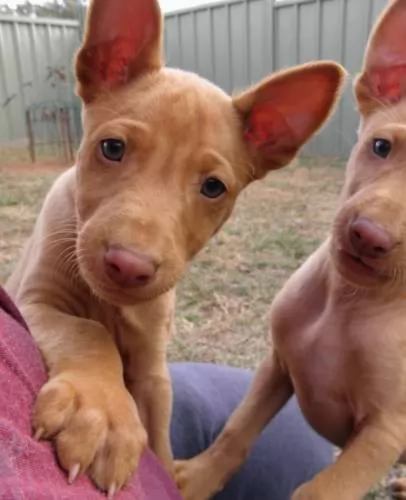 Pharaoh Hounds are uncommon outside of the Maltese Islands and with very little irresponsible breeding, these dogs are virtually free of genetic diseases. A common dog illness to look out for includes -
Pharaoh Hounds are uncommon outside of the Maltese Islands and with very little irresponsible breeding, these dogs are virtually free of genetic diseases. A common dog illness to look out for includes -
Patellar Luxation:
Your Pharaoh Hound can suffer from patella luxation, and in more severe cases it can be painful and even be disabling for a dog. This ailment comes about when the kneecap is dislocated from its normal position. You’ll find your dog lifting his hind leg quite a bit. Unfortunately this problem can lead to arthritis developing.
Other illnesses to look out for are bloat, cancer, skin allergies and ear infections.
Although most Beabulls will not have inherited health problems there are some issues they are all prone to:
• Bloat – can be fatal if not addressed immediately – inverted digestive organs.
• Hip Dysplasia – can cause lameness.
• Canine Disk Disease – can cause paralysis, loss of legs.
• Hypothyroidism
• Ear infections – keep them clean.
• Patellar Luxation – floating kneecaps – can cause lameness.
• Reverse Sneezing
Caring The Pet
Grooming:
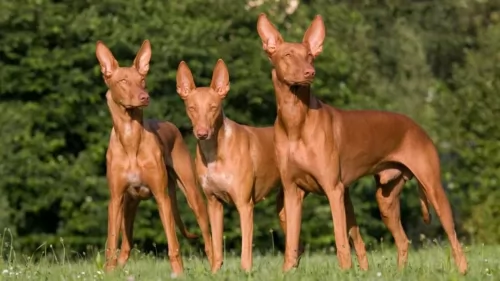 The Pharaoh Hound’s short coat is easy to groom and it will require a brushing at least twice a week just to get rid of loose hairs.
The Pharaoh Hound’s short coat is easy to groom and it will require a brushing at least twice a week just to get rid of loose hairs.
At the same time trim his nails, check inside his ears for infection and look inside his mouth for any rotting teeth.
Exercise:
Your Pharaoh Hound is an active, energetic dog and he will need a good dose of exercise every day. Take him with you on your walks or allow him to join you with your hikes, jogging or cycling. At home involve him in some ball games.
Diet:
How much any adult dog eats will depend on a number of factors such as size of dog, age and his activity levels.
You get some excellent dog kibble these days on the market but the idea is to choose one of the high quality ones which have minerals and vitamins in them. Home-made food is also good for your pet and this should be kept simple, consistent and nutritious.
Every now and then you can add in some boiled chicken, brown rice or pasta and sweet potato, carrots and spinach to the kibble. Some raw meat added in can also be of benefit to your dog’s health.
Stay away from spicy, exotic foods and keep your dog's food easy like suggested so as to avoid digestive problems
1.Feeding the puppy – Don’t overfeed due to tendency for obesity and don’t feed right before or after exercise due to threat of bloat. Feed 3-4 meals per day a total of 1.5 cups in a day.
2.Feeding the adult - Don’t overfeed due to tendency for obesity and don’t feed right before or after exercise due to threat of bloat. Feed 3-4 meals per day a total of 3 cups in a day.
3.Points for Good Health no hereditary issues
4. Games and Exercises – both the laziness of the Bulldog and the scent driven energy or the Beagle can be seen in the Beabull. They have short bursts of the Beagles hyperness. Enjoy playing fetch and participating in agility. They need a daily 45-60 minute walk.
Comparison with other breeds
- Beabull vs English Bulldog - Breed Comparison
- Beabull vs German Shepherd - Breed Comparison
- Beabull vs Golden Retriever - Breed Comparison
- Beabull vs Labrador Retriever - Breed Comparison
- Beabull vs West Highland White Terrier - Breed Comparison
- Beabull vs French Bulldog - Breed Comparison
- Beabull vs Beagle - Breed Comparison
- Beabull vs Yorkshire Terrier - Breed Comparison
- Beabull vs Poodle - Breed Comparison
- Beabull vs Rottweiler - Breed Comparison
- Beabull vs Boxer - Breed Comparison
- Beabull vs English Pointer - Breed Comparison
- Beabull vs Siberian Husky - Breed Comparison
- Beabull vs Doberman Pinscher - Breed Comparison
- Beabull vs American Bully - Breed Comparison
- Beabull vs Abruzzenhund - Breed Comparison
- Beabull vs Affenpinscher - Breed Comparison
- Beabull vs Afghan Hound - Breed Comparison
- Beabull vs Aidi - Breed Comparison
- Beabull vs Airedale Terrier - Breed Comparison
- Beabull vs Akbash Dog - Breed Comparison
- Beabull vs Akita - Breed Comparison
- Beabull vs Africanis - Breed Comparison
- Beabull vs Askal - Breed Comparison
- Beabull vs Atlas Terrier - Breed Comparison
- Pharaoh Hound vs English Bulldog - Breed Comparison
- Pharaoh Hound vs German Shepherd - Breed Comparison
- Pharaoh Hound vs Golden Retriever - Breed Comparison
- Pharaoh Hound vs Labrador Retriever - Breed Comparison
- Pharaoh Hound vs West Highland White Terrier - Breed Comparison
- Pharaoh Hound vs French Bulldog - Breed Comparison
- Pharaoh Hound vs Beagle - Breed Comparison
- Pharaoh Hound vs Yorkshire Terrier - Breed Comparison
- Pharaoh Hound vs Poodle - Breed Comparison
- Pharaoh Hound vs Rottweiler - Breed Comparison
- Pharaoh Hound vs Boxer - Breed Comparison
- Pharaoh Hound vs English Pointer - Breed Comparison
- Pharaoh Hound vs Siberian Husky - Breed Comparison
- Pharaoh Hound vs Doberman Pinscher - Breed Comparison
- Pharaoh Hound vs American Bully - Breed Comparison
- Pharaoh Hound vs Abruzzenhund - Breed Comparison
- Pharaoh Hound vs Affenpinscher - Breed Comparison
- Pharaoh Hound vs Afghan Hound - Breed Comparison
- Pharaoh Hound vs Aidi - Breed Comparison
- Pharaoh Hound vs Airedale Terrier - Breed Comparison
- Pharaoh Hound vs Akbash Dog - Breed Comparison
- Pharaoh Hound vs Akita - Breed Comparison
- Pharaoh Hound vs Africanis - Breed Comparison
- Pharaoh Hound vs Askal - Breed Comparison
- Pharaoh Hound vs Atlas Terrier - Breed Comparison
 Petzlover
Petzlover Pharaoh Hound is originated from Malta but Beabull is originated from United States. Pharaoh Hound may grow 23 cm / 10 inches higher than Beabull. Pharaoh Hound may weigh 14 kg / 31 pounds more than Beabull. Pharaoh Hound may live 3 years more than Beabull. Both Pharaoh Hound and Beabull has almost same litter size. Pharaoh Hound requires Low Maintenance. But Beabull requires Moderate Maintenance
Pharaoh Hound is originated from Malta but Beabull is originated from United States. Pharaoh Hound may grow 23 cm / 10 inches higher than Beabull. Pharaoh Hound may weigh 14 kg / 31 pounds more than Beabull. Pharaoh Hound may live 3 years more than Beabull. Both Pharaoh Hound and Beabull has almost same litter size. Pharaoh Hound requires Low Maintenance. But Beabull requires Moderate Maintenance The Pharaoh Hound hails from Malta and is the national dog there. These dogs are rare and are looked upon as endangered. Because they are a primitive type dog, they enjoy good health.
The Pharaoh Hound hails from Malta and is the national dog there. These dogs are rare and are looked upon as endangered. Because they are a primitive type dog, they enjoy good health. The Pharoah Hound is an elegant looking dog standing at roughly between 53 and 63cm and weighing 18 to 27kg.
The Pharoah Hound is an elegant looking dog standing at roughly between 53 and 63cm and weighing 18 to 27kg. The Pharaoh Hound is quite interesting in a number of ways and he is independent, strong-willed and able to entertain and amuse himself.
The Pharaoh Hound is quite interesting in a number of ways and he is independent, strong-willed and able to entertain and amuse himself. Pharaoh Hounds are uncommon outside of the Maltese Islands and with very little irresponsible breeding, these dogs are virtually free of genetic diseases. A common dog illness to look out for includes -
Pharaoh Hounds are uncommon outside of the Maltese Islands and with very little irresponsible breeding, these dogs are virtually free of genetic diseases. A common dog illness to look out for includes - The Pharaoh Hound’s short coat is easy to groom and it will require a brushing at least twice a week just to get rid of loose hairs.
The Pharaoh Hound’s short coat is easy to groom and it will require a brushing at least twice a week just to get rid of loose hairs.